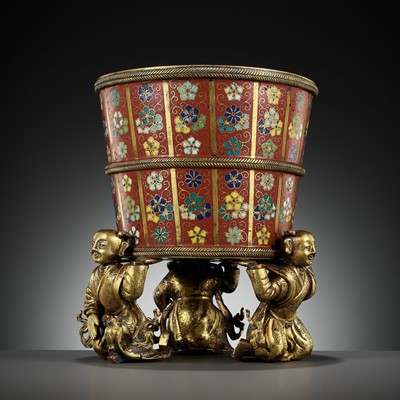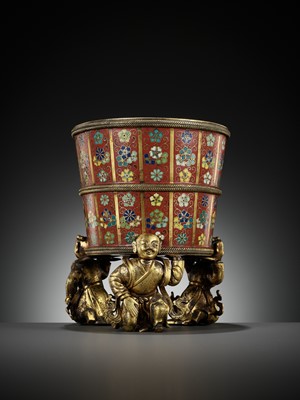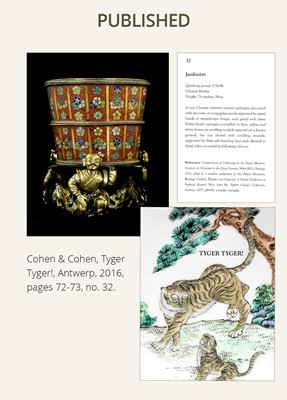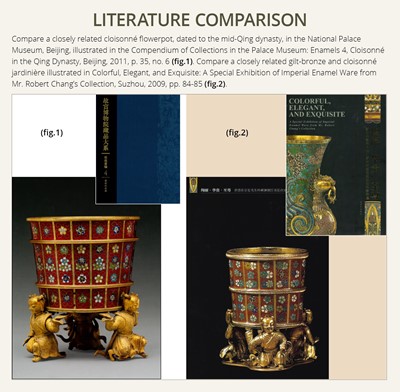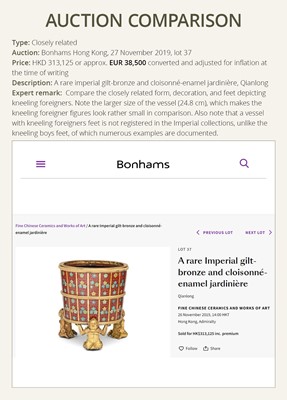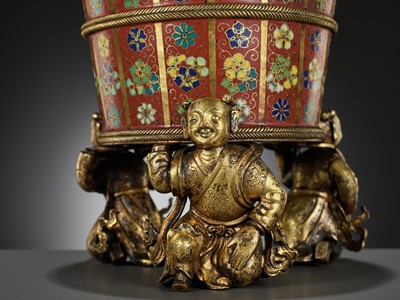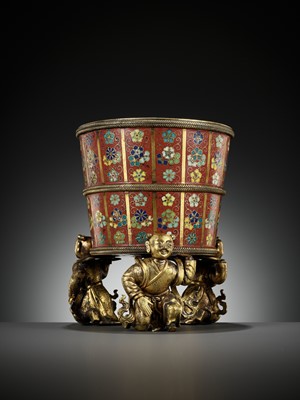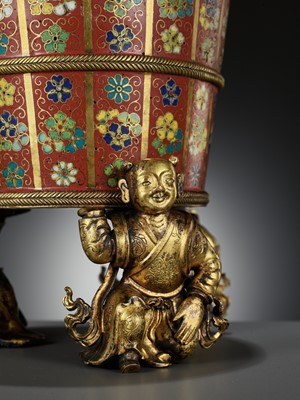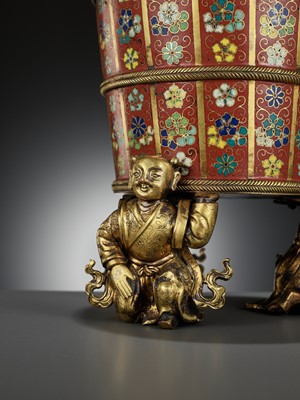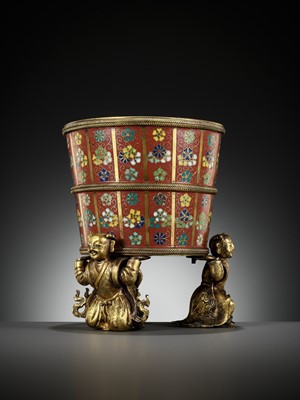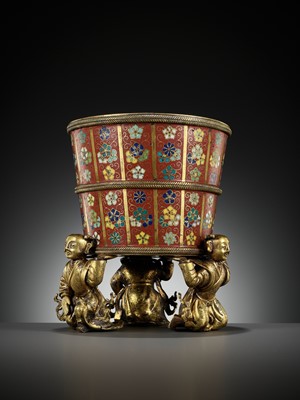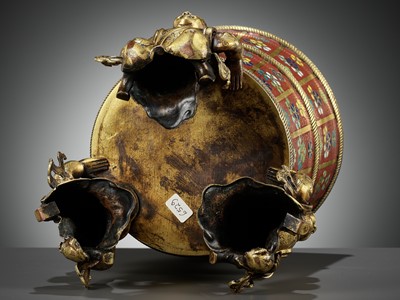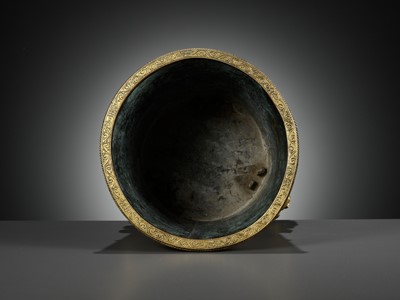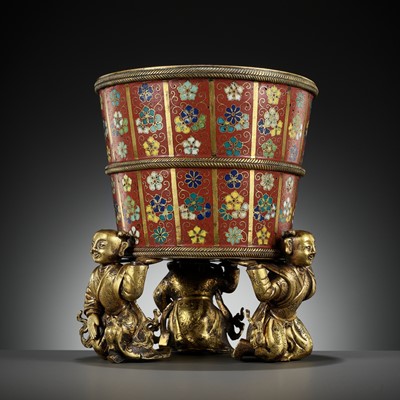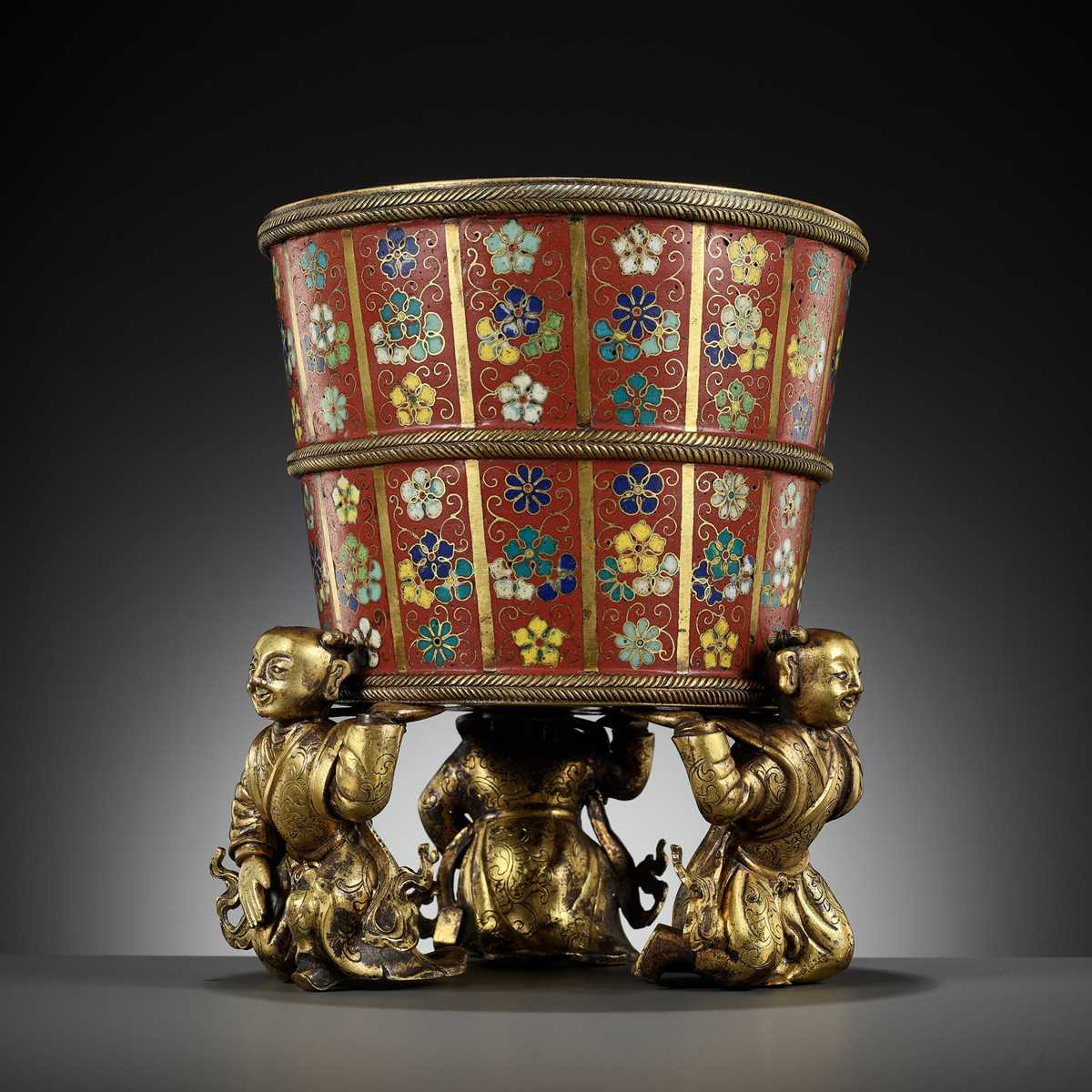11th Oct, 2023 11:00
THREE-DAY AUCTION - Fine Chinese Art / 中國藝術集珍 / Buddhism & Hinduism
4
AN IMPERIAL CLOISONNÉ ENAMEL JARDINIÈRE, SUPPORTED BY THREE GILT-BRONZE ‘KNEELING BOYS’ FEET, QIANLONG PERIOD
乾隆時期御製銅胎掐絲琺瑯三足盆
Sold for €18,200
including Buyer's Premium
Published: Cohen & Cohen, Tyger Tyger!, Antwerp, 2016, pages 72-73, no. 32.
China, 1736-1795. The vessel with gently flared sides and supported by three feet, cast in gilt copper-alloy as kneeling boys dressed in voluminous robes incised with lotus blossoms and leafy vines, draped in billowing scarves, their faces well detailed with smiling expressions. The exterior of the vessel finely decorated with two rows of rectangular panels separated by raised gilt bands of twisted-rope design, each panel with five flowerheads brightly enameled in shades on a of blue, yellow, green, and white, borne on scrolling tendrils reserved on a rich red ground. The rim neatly incised with lotus blossoms and foliate scroll.
Provenance: Cohen & Cohen, Antwerp, 2016. A noted private collection in New York, USA, acquired from the above.
Condition: Excellent condition with some old wear, expected small losses with associated old fills, minor rubbing to gilt, minor nicks to enamels and metals. Shallow surface scratches. Expected manufacturing flaws such as minimal pitting. The interior has a good naturally grown patina with malachite encrustations.
Weight: 1,484 g
Dimensions: Height 18.2 cm, Diameter 15.5 cm
Please click here to read the full description
The present vessel’s bucket shape echoes a rustic wooden pail with vertical slats bound by rope and is clearly designed as an amusing variant of this standard artisan vessel, executed in expensive cloisonné enamels. Such conceits were very popular with the early Qing emperors, who took a particular pleasure in instructing their Palace and external craftsmen to recreate familiar objects in entirely different materials: archaic bronzes in jade, eel-trap nets in porcelain, bronze incense burners in lapis lazuli, or rhinoceros horn carvings in silver.
Jardinières of this shape still exist in the Qing Court Collections and have been published. Indeed, some still survive with additional embellishments at the top confirming that they were intended to be displayed in the Forbidden City and other Imperial palaces as pails of flowers, because some were deliberately fitted with simulated flower arrangements comprising miniature flowering trees, created with curling wire branches and suspending green hardstone leaves set with carnelian, crystal and other semi-precious hardstones.
Literature comparison:
Compare a closely related cloisonné flowerpot, dated to the mid-Qing dynasty, in the National Palace Museum, Beijing, illustrated in the Compendium of Collections in the Palace Museum: Enamels 4, Cloisonné in the Qing Dynasty, Beijing, 2011, p. 35, no. 6. Compare a closely related gilt-bronze and cloisonné jardinière illustrated in Colorful, Elegant, and Exquisite: A Special Exhibition of Imperial Enamel Ware from Mr. Robert Chang’s Collection, Suzhou, 2009, pp. 84-85. Compare a closely related gilt-bronze and red cloisonné-enamel jardinière supported by three boys, dated to the mid-Qing dynasty, illustrated in the Prime Cultural Relics Collected by Shenyang Imperial Palace Museum: The Enamel Volume, Shenyang, 2007, pp. 204-205. This example shows that the jardinière was used to hold hardstone imitations of auspicious flowers.
Auction result comparison:
Type: Closely related
Auction: Bonhams Hong Kong, 27 November 2019, lot 37
Price: HKD 313,125 or approx. EUR 38,500 converted and adjusted for inflation at the time of writing
Description: A rare imperial gilt-bronze and cloisonné-enamel jardinière, Qianlong
Expert remark: Compare the closely related form, decoration, and feet depicting kneeling foreigners. Note the larger size of the vessel (24.8 cm), which makes the kneeling foreigner figures look rather small in comparison. Also note that a vessel with kneeling foreigners feet is not registered in the Imperial collections, unlike the kneeling boys feet, of which numerous examples are documented.
点此阅读中文翻译 (Chinese Translation)
乾隆時期御製銅胎掐絲琺瑯三足盆
中國, 1736-1795年。盆斜腹敞口,三童子以跪姿肩負盆。童子為鎏金銅,穿著纏枝蓮花紋長袍,面露微笑。盆外壁如木桶狀,紅地飾花卉錦地,三道扭繩撞的鎏金束繩。琺瑯色彩明亮生動。盆口工整地刻有卷葉蓮紋。
出版:Cohen & Cohen, Tyger Tyger!, 安特衛普, 2016, 72-73頁, 圖 32。
來源:安特衛普Cohen & Cohen藝廊, 2016年;美國紐約知名私人收藏,購於上述藝廊。
品相:狀況極佳,有一些磨損,缺損有相應的修補,鎏金有輕微摩擦,琺瑯和金屬上有微小的刻痕。表面有淺劃痕。鑄造不規則,例如麻點。內部自然包漿,綠色結殼。
重量:1,484 克
尺寸:高 18.2 厘米, 直徑 15.5 厘米
本容器的桶形與鄉村風格的木桶相呼應,木桶上有用繩子捆紮的垂直板條,採用昂貴的景泰藍琺瑯製成。 這種奇思妙想在清初宮中非常流行,宮廷和民間工匠用完全不同的材料再現熟悉的物品,如玉制的古代青銅器、瓷器、青金石的青銅香爐,或用銀犀牛角雕刻。
此造型的花盆仍清宮藏品中見到,並已出版。頂部有額外的裝飾,可見它們是用來在宮中作爲花盆使用。也有用銅線製成的微型花樹和懸掛的綠色硬石葉子鑲嵌著紅玉髓、水晶和其他半寶石。
文獻比較:
比較一件非常相近的清中期掐絲琺瑯朵花紋人足筒式花盆,收藏於北京故宮博物院,見《故宮博物院藏品大系‧琺瑯器編》,北京,2011年,頁35,編號6。比較一件非常相近的鎏金掐絲琺瑯大盆,見《Colorful,Elegant,and Exquisite: A Special Exhibition of Imperial Enamel Ware from Mr. Robert Chang’s Collection》,蘇州,2009年,頁84-85。比較一件非常相近的清中期鎏金青銅和紅色景泰藍琺瑯花盆,見《Prime Cultural Relics Collected by Shenyang Imperial Palace Museum: The Enamel Volume》,瀋陽,2007年,頁204-205。
拍賣結果比較:
形制:非常相近
拍賣:香港邦瀚斯,2019年11月27日,lot 37
價格:HKD 313,125(相當於今日EUR 38,500)
描述:清乾隆掐絲琺瑯朵花紋人足筒式花盆
專家評論:比較非常相近的外形、裝飾,以及足部為跪姿的外國人。請注意尺寸較大 (24.8 釐米),與跪姿三童子足不同,此跪姿外國人足花盆沒有被記錄在皇家收藏中
Published: Cohen & Cohen, Tyger Tyger!, Antwerp, 2016, pages 72-73, no. 32.
China, 1736-1795. The vessel with gently flared sides and supported by three feet, cast in gilt copper-alloy as kneeling boys dressed in voluminous robes incised with lotus blossoms and leafy vines, draped in billowing scarves, their faces well detailed with smiling expressions. The exterior of the vessel finely decorated with two rows of rectangular panels separated by raised gilt bands of twisted-rope design, each panel with five flowerheads brightly enameled in shades on a of blue, yellow, green, and white, borne on scrolling tendrils reserved on a rich red ground. The rim neatly incised with lotus blossoms and foliate scroll.
Provenance: Cohen & Cohen, Antwerp, 2016. A noted private collection in New York, USA, acquired from the above.
Condition: Excellent condition with some old wear, expected small losses with associated old fills, minor rubbing to gilt, minor nicks to enamels and metals. Shallow surface scratches. Expected manufacturing flaws such as minimal pitting. The interior has a good naturally grown patina with malachite encrustations.
Weight: 1,484 g
Dimensions: Height 18.2 cm, Diameter 15.5 cm
Please click here to read the full description
The present vessel’s bucket shape echoes a rustic wooden pail with vertical slats bound by rope and is clearly designed as an amusing variant of this standard artisan vessel, executed in expensive cloisonné enamels. Such conceits were very popular with the early Qing emperors, who took a particular pleasure in instructing their Palace and external craftsmen to recreate familiar objects in entirely different materials: archaic bronzes in jade, eel-trap nets in porcelain, bronze incense burners in lapis lazuli, or rhinoceros horn carvings in silver.
Jardinières of this shape still exist in the Qing Court Collections and have been published. Indeed, some still survive with additional embellishments at the top confirming that they were intended to be displayed in the Forbidden City and other Imperial palaces as pails of flowers, because some were deliberately fitted with simulated flower arrangements comprising miniature flowering trees, created with curling wire branches and suspending green hardstone leaves set with carnelian, crystal and other semi-precious hardstones.
Literature comparison:
Compare a closely related cloisonné flowerpot, dated to the mid-Qing dynasty, in the National Palace Museum, Beijing, illustrated in the Compendium of Collections in the Palace Museum: Enamels 4, Cloisonné in the Qing Dynasty, Beijing, 2011, p. 35, no. 6. Compare a closely related gilt-bronze and cloisonné jardinière illustrated in Colorful, Elegant, and Exquisite: A Special Exhibition of Imperial Enamel Ware from Mr. Robert Chang’s Collection, Suzhou, 2009, pp. 84-85. Compare a closely related gilt-bronze and red cloisonné-enamel jardinière supported by three boys, dated to the mid-Qing dynasty, illustrated in the Prime Cultural Relics Collected by Shenyang Imperial Palace Museum: The Enamel Volume, Shenyang, 2007, pp. 204-205. This example shows that the jardinière was used to hold hardstone imitations of auspicious flowers.
Auction result comparison:
Type: Closely related
Auction: Bonhams Hong Kong, 27 November 2019, lot 37
Price: HKD 313,125 or approx. EUR 38,500 converted and adjusted for inflation at the time of writing
Description: A rare imperial gilt-bronze and cloisonné-enamel jardinière, Qianlong
Expert remark: Compare the closely related form, decoration, and feet depicting kneeling foreigners. Note the larger size of the vessel (24.8 cm), which makes the kneeling foreigner figures look rather small in comparison. Also note that a vessel with kneeling foreigners feet is not registered in the Imperial collections, unlike the kneeling boys feet, of which numerous examples are documented.
点此阅读中文翻译 (Chinese Translation)
乾隆時期御製銅胎掐絲琺瑯三足盆
中國, 1736-1795年。盆斜腹敞口,三童子以跪姿肩負盆。童子為鎏金銅,穿著纏枝蓮花紋長袍,面露微笑。盆外壁如木桶狀,紅地飾花卉錦地,三道扭繩撞的鎏金束繩。琺瑯色彩明亮生動。盆口工整地刻有卷葉蓮紋。
出版:Cohen & Cohen, Tyger Tyger!, 安特衛普, 2016, 72-73頁, 圖 32。
來源:安特衛普Cohen & Cohen藝廊, 2016年;美國紐約知名私人收藏,購於上述藝廊。
品相:狀況極佳,有一些磨損,缺損有相應的修補,鎏金有輕微摩擦,琺瑯和金屬上有微小的刻痕。表面有淺劃痕。鑄造不規則,例如麻點。內部自然包漿,綠色結殼。
重量:1,484 克
尺寸:高 18.2 厘米, 直徑 15.5 厘米
本容器的桶形與鄉村風格的木桶相呼應,木桶上有用繩子捆紮的垂直板條,採用昂貴的景泰藍琺瑯製成。 這種奇思妙想在清初宮中非常流行,宮廷和民間工匠用完全不同的材料再現熟悉的物品,如玉制的古代青銅器、瓷器、青金石的青銅香爐,或用銀犀牛角雕刻。
此造型的花盆仍清宮藏品中見到,並已出版。頂部有額外的裝飾,可見它們是用來在宮中作爲花盆使用。也有用銅線製成的微型花樹和懸掛的綠色硬石葉子鑲嵌著紅玉髓、水晶和其他半寶石。
文獻比較:
比較一件非常相近的清中期掐絲琺瑯朵花紋人足筒式花盆,收藏於北京故宮博物院,見《故宮博物院藏品大系‧琺瑯器編》,北京,2011年,頁35,編號6。比較一件非常相近的鎏金掐絲琺瑯大盆,見《Colorful,Elegant,and Exquisite: A Special Exhibition of Imperial Enamel Ware from Mr. Robert Chang’s Collection》,蘇州,2009年,頁84-85。比較一件非常相近的清中期鎏金青銅和紅色景泰藍琺瑯花盆,見《Prime Cultural Relics Collected by Shenyang Imperial Palace Museum: The Enamel Volume》,瀋陽,2007年,頁204-205。
拍賣結果比較:
形制:非常相近
拍賣:香港邦瀚斯,2019年11月27日,lot 37
價格:HKD 313,125(相當於今日EUR 38,500)
描述:清乾隆掐絲琺瑯朵花紋人足筒式花盆
專家評論:比較非常相近的外形、裝飾,以及足部為跪姿的外國人。請注意尺寸較大 (24.8 釐米),與跪姿三童子足不同,此跪姿外國人足花盆沒有被記錄在皇家收藏中
Zacke Live Online Bidding
Our online bidding platform makes it easier than ever to bid in our auctions! When you bid through our website, you can take advantage of our premium buyer's terms without incurring any additional online bidding surcharges.
To bid live online, you'll need to create an online account. Once your account is created and your identity is verified, you can register to bid in an auction up to 12 hours before the auction begins.
Intended Spend and Bid Limits
When you register to bid in an online auction, you will need to share your intended maximum spending budget for the auction. We will then review your intended spend and set a bid limit for you. Once you have pre-registered for a live online auction, you can see your intended spend and bid limit by going to 'Account Settings' and clicking on 'Live Bidding Registrations'.
Your bid limit will be the maximum amount you can bid during the auction. Your bid limit is for the hammer price and is not affected by the buyer’s premium and VAT. For example, if you have a bid limit of €1,000 and place two winning bids for €300 and €200, then you will only be able to bid €500 for the rest of the auction. If you try to place a bid that is higher than €500, you will not be able to do so.
Online Absentee and Telephone Bids
You can now leave absentee and telephone bids on our website!
Absentee Bidding
Once you've created an account and your identity is verified, you can leave your absentee bid directly on the lot page. We will contact you when your bids have been confirmed.
Telephone Bidding
Once you've created an account and your identity is verified, you can leave telephone bids online. We will contact you when your bids have been confirmed.
Classic Absentee and Telephone Bidding Form
You can still submit absentee and telephone bids by email or fax if you prefer. Simply fill out the Absentee Bidding/Telephone bidding form and return it to us by email at office@zacke.at or by fax at +43 (1) 532 04 52 20. You can download the PDF from our Upcoming Auctions page.
How-To Guides
How to Create Your Personal Zacke Account
How to Register to Bid on Zacke Live
How to Leave Absentee Bids Online
How to Leave Telephone Bids Online
中文版本的操作指南
创建新账号
注册Zacke Live在线直播竞拍(免平台费)
缺席投标和电话投标
Third-Party Bidding
We partner with best-in-class third-party partners to make it easy for you to bid online in the channel of your choice. Please note that if you bid with one of our third-party online partners, then there will be a live bidding surcharge on top of your final purchase price. You can find all of our fees here. Here's a full list of our third-party partners:
- 51 Bid Live
- EpaiLive
- ArtFoxLive
- Invaluable
- LiveAuctioneers
- the-saleroom
- lot-tissimo
- Drouot
Please note that we place different auctions on different platforms. For example, in general, we only place Chinese art auctions on 51 Bid Live.
Bidding in Person
You must register to bid in person and will be assigned a paddle at the auction. Please contact us at office@zacke.at or +43 (1) 532 04 52 for the latest local health and safety guidelines.
